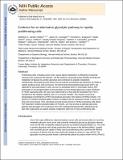| dc.contributor.author | Vander Heiden, Matthew G. | |
| dc.contributor.author | Locasale, Jason W. | |
| dc.contributor.author | Swanson, Kenneth D. | |
| dc.contributor.author | Sharfi, Hadar | |
| dc.contributor.author | Heffron, Gregory J. | |
| dc.contributor.author | Amador-Noguez, Daniel | |
| dc.contributor.author | Christofk, Heather R. | |
| dc.contributor.author | Wagner, Gerhard | |
| dc.contributor.author | Rabinowitz, Joshua D. | |
| dc.contributor.author | Asara, John M. | |
| dc.contributor.author | Cantley, Lewis C. | |
| dc.date.accessioned | 2014-02-27T17:09:54Z | |
| dc.date.available | 2014-02-27T17:09:54Z | |
| dc.date.issued | 2010-09 | |
| dc.date.submitted | 2010-02 | |
| dc.identifier.issn | 0036-8075 | |
| dc.identifier.issn | 1095-9203 | |
| dc.identifier.uri | http://hdl.handle.net/1721.1/85108 | |
| dc.description.abstract | Proliferating cells, including cancer cells, require altered metabolism to efficiently incorporate nutrients such as glucose into biomass. The M2 isoform of pyruvate kinase (PKM2) promotes the metabolism of glucose by aerobic glycolysis and contributes to anabolic metabolism. Paradoxically, decreased pyruvate kinase enzyme activity accompanies the expression of PKM2 in rapidly dividing cancer cells and tissues. We demonstrate that phosphoenolpyruvate (PEP), the substrate for pyruvate kinase in cells, can act as a phosphate donor in mammalian cells because PEP participates in the phosphorylation of the glycolytic enzyme phosphoglycerate mutase (PGAM1) in PKM2-expressing cells. We used mass spectrometry to show that the phosphate from PEP is transferred to the catalytic histidine (His11) on human PGAM1. This reaction occurred at physiological concentrations of PEP and produced pyruvate in the absence of PKM2 activity. The presence of histidine-phosphorylated PGAM1 correlated with the expression of PKM2 in cancer cell lines and tumor tissues. Thus, decreased pyruvate kinase activity in PKM2-expressing cells allows PEP-dependent histidine phosphorylation of PGAM1 and may provide an alternate glycolytic pathway that decouples adenosine triphosphate production from PEP-mediated phosphotransfer, allowing for the high rate of glycolysis to support the anabolic metabolism observed in many proliferating cells. | en_US |
| dc.description.sponsorship | Damon Runyon Cancer Research Foundation | en_US |
| dc.description.sponsorship | Burroughs Wellcome Fund | en_US |
| dc.description.sponsorship | American Cancer Society | en_US |
| dc.description.sponsorship | Dana-Farber/Harvard Cancer Center | en_US |
| dc.description.sponsorship | National Institutes of Health (U.S.) (NIH 1K08CA136983) | en_US |
| dc.description.sponsorship | National Institutes of Health (U.S.) (NIH 5P30CA006516-43) | en_US |
| dc.description.sponsorship | National Institutes of Health (U.S.) (NIH 5 T32 CA009361-28) | en_US |
| dc.description.sponsorship | National Institutes of Health (U.S.) (NIH R21/R33 DK070299) | en_US |
| dc.description.sponsorship | National Institutes of Health (U.S.) (NIH P01GM047467) | en_US |
| dc.description.sponsorship | National Institutes of Health (U.S.) (NIH R01 AI078063) | en_US |
| dc.description.sponsorship | National Institutes of Health (U.S.) (NIH R21 CA12862) | en_US |
| dc.description.sponsorship | National Institutes of Health (U.S.) (NIH R01-GM56302) | en_US |
| dc.description.sponsorship | United States. Public Health Service (NIH P01CA089021) | en_US |
| dc.description.sponsorship | National Institutes of Health (U.S.) (NIH 1P01CA120964-01A) | en_US |
| dc.language.iso | en_US | |
| dc.publisher | American Association for the Advancement of Science | en_US |
| dc.relation.isversionof | http://dx.doi.org/10.1126/science.1188015 | en_US |
| dc.rights | Article is made available in accordance with the publisher's policy and may be subject to US copyright law. Please refer to the publisher's site for terms of use. | en_US |
| dc.source | PMC | en_US |
| dc.title | Evidence for an Alternative Glycolytic Pathway in Rapidly Proliferating Cells | en_US |
| dc.type | Article | en_US |
| dc.identifier.citation | Vander Heiden, Matthew G., Jason W. Locasale, Kenneth D. Swanson, Hadar Sharfi, Greg J. Heffron, Daniel Amador-Noguez, Heather R. Christofk, Gerhard Wagner, Joshua D. Rabinowitz, John M. Asara, and Lewis C. Cantley. "Evidence for an Alternative Glycolytic Pathway in Rapidly Proliferating Cells." Science 17 September 2010: 329 (5998), 1492-1499. | en_US |
| dc.contributor.department | Massachusetts Institute of Technology. Department of Biology | en_US |
| dc.contributor.department | Koch Institute for Integrative Cancer Research at MIT | en_US |
| dc.contributor.mitauthor | Vander Heiden, Matthew G. | en_US |
| dc.relation.journal | Science | en_US |
| dc.eprint.version | Author's final manuscript | en_US |
| dc.type.uri | http://purl.org/eprint/type/JournalArticle | en_US |
| eprint.status | http://purl.org/eprint/status/PeerReviewed | en_US |
| dspace.orderedauthors | Vander Heiden, M. G.; Locasale, J. W.; Swanson, K. D.; Sharfi, H.; Heffron, G. J.; Amador-Noguez, D.; Christofk, H. R.; Wagner, G.; Rabinowitz, J. D.; Asara, J. M.; Cantley, L. C. | en_US |
| dc.identifier.orcid | https://orcid.org/0000-0002-6702-4192 | |
| mit.license | PUBLISHER_POLICY | en_US |
| mit.metadata.status | Complete | |
